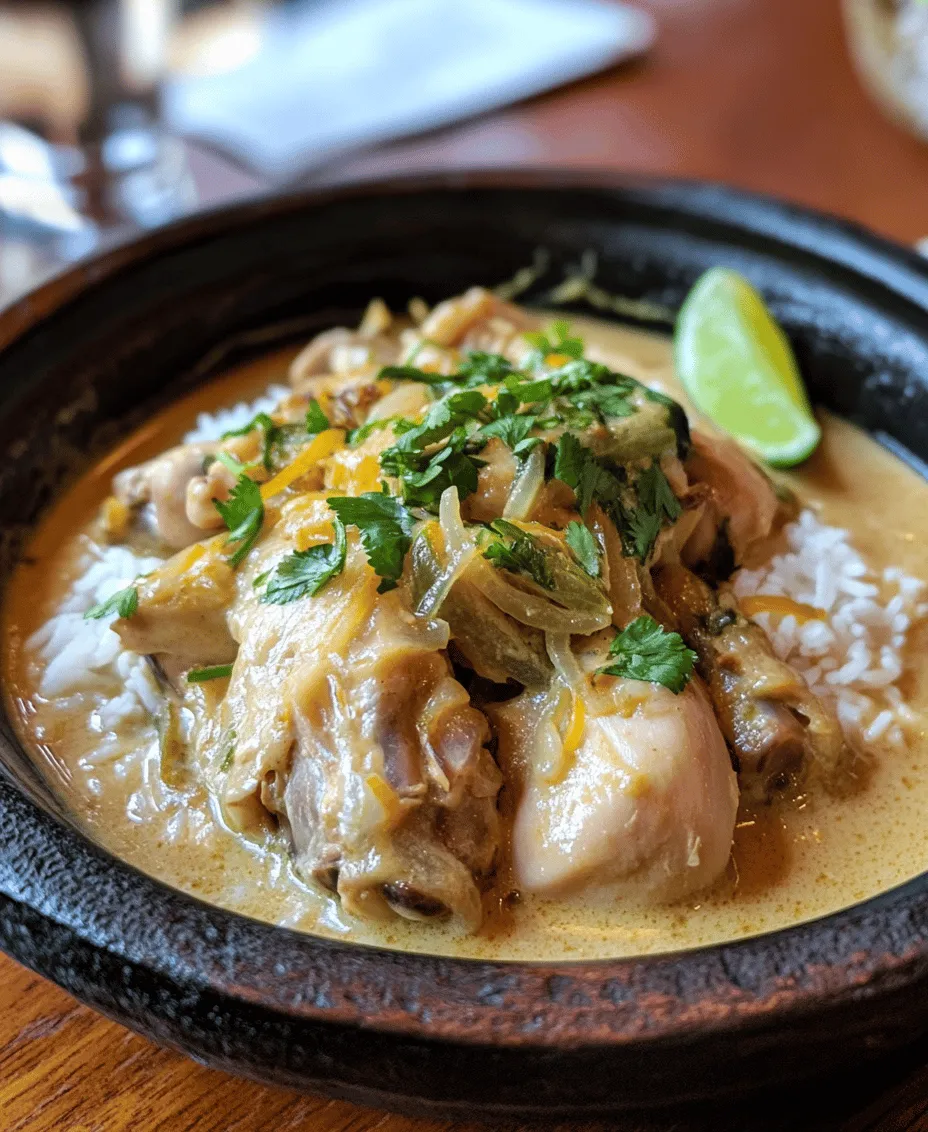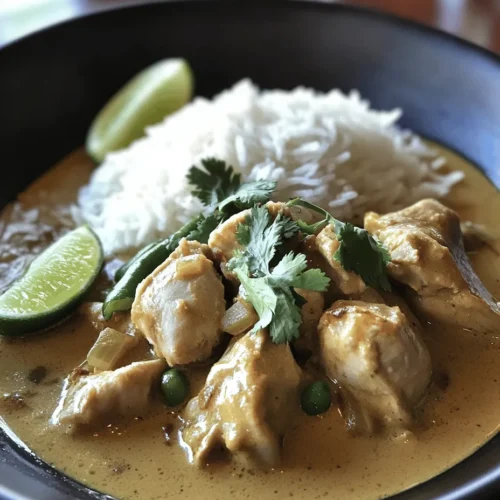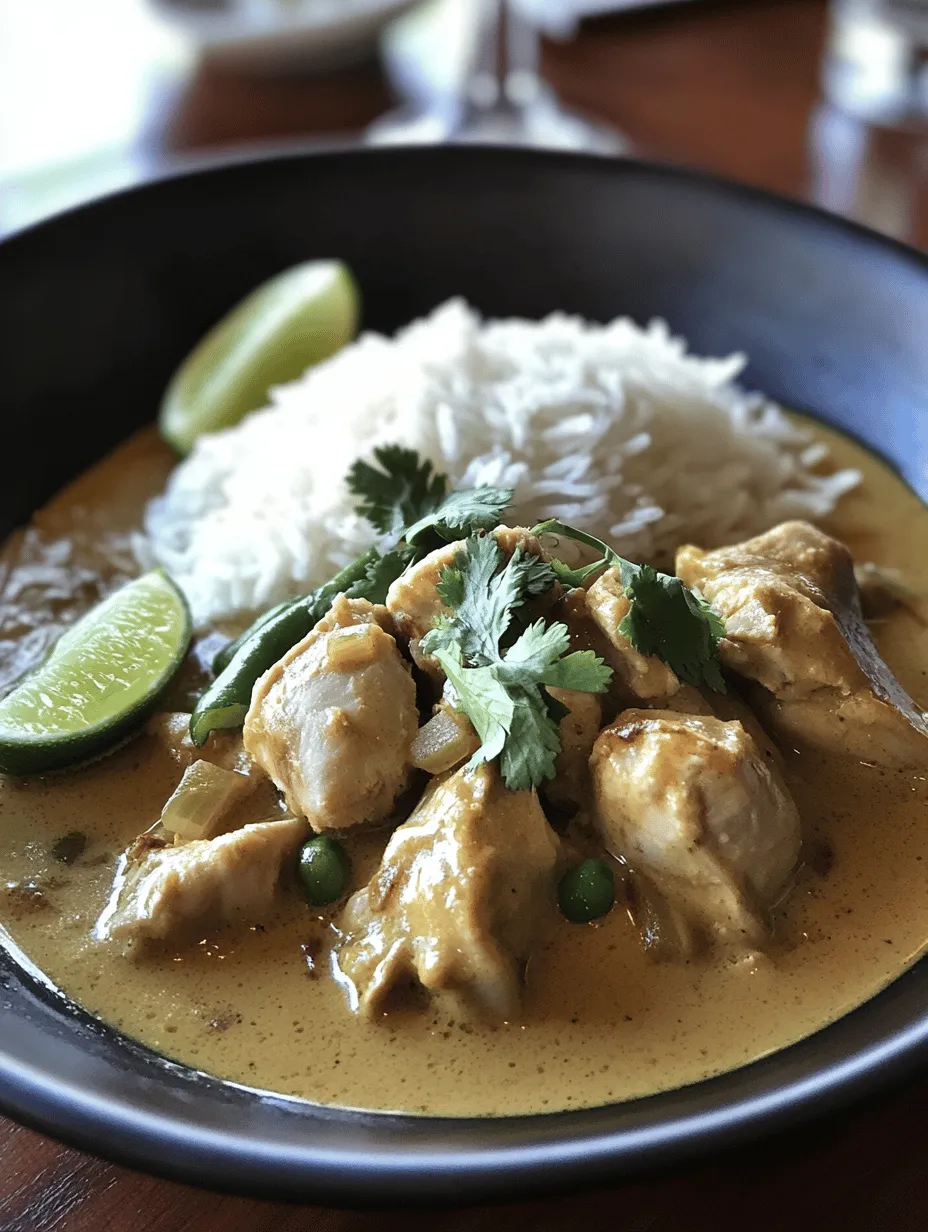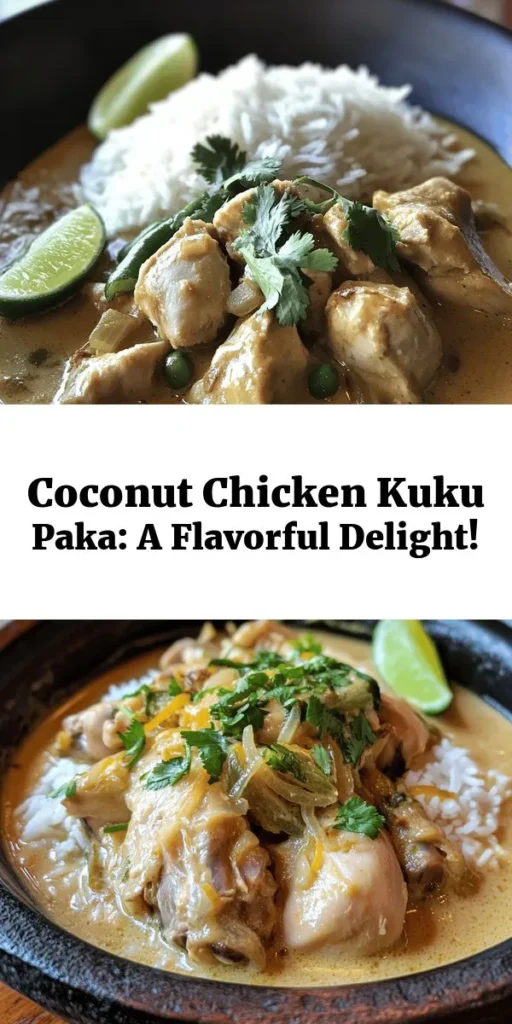Introduction
Kuku Paka Delight is more than just a meal; it’s an experience that captivates the senses and transports you to the lush landscapes of East Africa. This aromatic dish masterfully combines the creamy richness of coconut milk with a symphony of spices, creating a culinary delight that is both comforting and exotic. For food enthusiasts searching for unique flavors, Kuku Paka offers a wonderful balance of warmth and depth, making it an ideal choice for any occasion—whether it’s a simple weeknight dinner or a festive gathering with friends and family.
Originating from the coastal regions of East Africa, particularly Kenya and Tanzania, Kuku Paka symbolizes the region’s rich culinary heritage, drawing influences from both African and Asian cuisines. The dish is a testament to the vibrant cultures that have shaped the coastal communities, where spices and coconut milk are staples in local cooking. As you delve into the preparation of Kuku Paka, you will discover not only a delicious recipe but also a story that embodies the blend of traditions and flavors that define this remarkable dish.
One of the remarkable aspects of Kuku Paka Delight is its simplicity. With a few key ingredients and straightforward steps, this dish can be prepared with ease, making it accessible for both novice cooks and seasoned chefs alike. The simplicity does not compromise flavor; instead, it enhances the dish’s appeal, allowing the natural ingredients to shine. Prepare to embark on a culinary journey that will elevate your cooking and tantalize your taste buds with the rich flavors of Kuku Paka Delight.
Understanding Kuku Paka
Kuku Paka’s roots can be traced back to the vibrant culinary traditions of the Swahili coast, where the fusion of spices and ingredients from various cultures is a hallmark of the region’s cooking. The name “Kuku Paka” translates to “chicken in coconut” in Swahili, aptly describing the dish’s core essence. This dish showcases the versatility of chicken, which is marinated and cooked in a luscious coconut milk sauce, infused with aromatic spices that elevate its flavor profile.
As Kuku Paka has evolved over time, there are numerous variations across East Africa. Each region has its interpretation, influenced by local ingredients and cooking methods. For instance, some recipes may incorporate additional vegetables or different types of meat, while others may adjust the spice levels according to personal taste. Regardless of these variations, the heart of Kuku Paka remains the same—a celebration of rich flavors and the art of cooking with love.
The cultural significance of Kuku Paka extends beyond its delicious taste. It is often served during special occasions or family gatherings, symbolizing togetherness and the joy of sharing a meal. As you prepare this dish, you are not just following a recipe; you are participating in a culinary tradition that has been passed down through generations.
Ingredient Spotlight
To fully appreciate the flavors of Kuku Paka Delight, it’s essential to understand the key ingredients that contribute to its unique profile. Each component plays a crucial role in creating the dish’s depth and character while also offering various health benefits.
Chicken
The star ingredient of Kuku Paka Delight is, of course, chicken. For the best flavor and texture, it is recommended to use bone-in pieces, such as thighs or drumsticks. The bones not only enhance the taste during cooking but also contribute to a more succulent and tender result. As the chicken simmers in the coconut milk, the meat absorbs the aromatic spices, resulting in a deliciously infused dish.
Coconut Milk
Coconut milk is the heart of Kuku Paka, providing its signature creaminess and rich flavor. Beyond its delectable taste, coconut milk is also known for its health benefits. It contains healthy fats, particularly medium-chain triglycerides (MCTs), which may support weight management and improve metabolic health. Additionally, coconut milk is a good source of vitamins and minerals, including magnesium, potassium, and iron, making it a nutritious addition to the dish.
Aromatics
A blend of aromatics is essential for building the foundational flavors of Kuku Paka. Onions, garlic, ginger, and green chilies come together to create a fragrant base that enhances the overall taste. Onions provide sweetness and depth, while garlic and ginger add warmth and a hint of spice. Green chilies introduce a gentle heat that can be adjusted based on your preference, allowing for a personalized touch to the dish.
Spices
The use of spices is what truly sets Kuku Paka apart. A combination of curry powder, ground cumin, ground coriander, and turmeric creates a harmonious blend that infuses the chicken and coconut milk with layers of flavor.
– Curry Powder: This spice blend often contains a mix of turmeric, cumin, coriander, and fenugreek, contributing to the dish’s vibrant color and complex flavor. It is also known for its anti-inflammatory properties.
– Ground Cumin: With its warm, earthy flavor, cumin adds depth to the dish and is known to aid digestion.
– Ground Coriander: This spice imparts a citrusy note that brightens the overall flavor profile and is rich in antioxidants.
– Turmeric: Renowned for its health benefits, turmeric not only adds a beautiful golden hue but also boasts anti-inflammatory and antioxidant properties.
Garnishes
Finally, the garnishes of fresh coriander and lime play a crucial role in elevating Kuku Paka Delight’s presentation and taste. Fresh coriander adds a burst of freshness that complements the rich coconut milk, while a squeeze of lime juice brightens the dish, balancing the creaminess with a zesty kick. These finishing touches are not merely decorative; they enhance the overall sensory experience of the meal.
Preparation of Kuku Paka Delight
Now that we have an understanding of the origins and key components of Kuku Paka Delight, let’s dive into the step-by-step preparation of this delightful dish.
Step 1: Marinate the Chicken
To begin, start by marinating the chicken pieces to infuse flavor. In a bowl, combine your chicken with a sprinkle of salt, a touch of curry powder, and a squeeze of lime juice. Let it marinate for at least 30 minutes to allow the spices to penetrate the meat. For best results, marinate the chicken overnight in the refrigerator.
Step 2: Sauté the Aromatics
In a large pot or deep skillet, heat a couple of tablespoons of oil over medium heat. Once hot, add finely chopped onions and sauté until they become translucent and slightly caramelized. This will take about 5-7 minutes. Next, add minced garlic, grated ginger, and chopped green chilies. Sauté for an additional 2-3 minutes until fragrant, stirring occasionally.
Step 3: Add the Spices
Once the aromatics are nicely cooked, it’s time to add the spices. Sprinkle in the ground cumin, ground coriander, and turmeric, stirring well to coat the aromatics. Allow the spices to bloom for about a minute, releasing their essential oils and intensifying their flavors.
Step 4: Cook the Chicken
Add the marinated chicken pieces to the pot, stirring to coat them in the spiced aromatic mixture. Allow the chicken to brown slightly for about 5 minutes, turning occasionally to ensure even cooking. This step is crucial for developing a rich flavor base for the Kuku Paka.
Step 5: Incorporate the Coconut Milk
After the chicken has browned, pour in the coconut milk, stirring to combine everything. Bring the mixture to a gentle simmer, then reduce the heat to low. Cover the pot and let the chicken cook for about 30-40 minutes, or until it is cooked through and tender. The slow cooking allows the chicken to absorb the flavors, creating a mouthwatering dish.
Step 6: Finish with Garnishes
Once the chicken is fully cooked, taste the sauce and adjust the seasoning if necessary. The final touch is to sprinkle freshly chopped coriander over the dish and serve with lime wedges on the side. This not only adds a pop of color but also enhances the dish’s flavor with a fresh, zesty note.
With these steps, you are well on your way to creating a delicious Kuku Paka Delight that will impress your family and friends. The combination of tender chicken, creamy coconut milk, and aromatic spices creates a meal that is both satisfying and memorable. As you prepare to serve this delightful dish, you’ll find that Kuku Paka is not just a recipe; it’s a celebration of flavors that brings people together.

Marination: Deepening Flavor
To truly capture the essence of Kuku Paka Delight, marinating the chicken is a crucial step that should not be overlooked. Marination allows the chicken to absorb all the flavors from the spices and coconut milk, resulting in a more flavorful and tender dish. Ideally, the chicken should be marinated for at least 1 hour, but if time permits, letting it sit overnight in the refrigerator will yield even better results. The combination of spices such as turmeric, coriander, and cumin, along with the creamy coconut milk, forms a marinade that not only tenderizes the meat but also infuses it with a delightful depth of flavor.
Sautéing Aromatics: Building Flavor Foundations
Once the chicken is marinated and ready, the next step is to sauté the aromatics. Start by heating a generous amount of oil in a large skillet or pot over medium heat. Add finely chopped onions and cook them until they become translucent and slightly caramelized. This process usually takes about 5-7 minutes. Sautéing onions not only adds a sweetness to the dish but also provides a rich base for the flavors to build upon. Once the onions are ready, you can add minced garlic and ginger, cooking for an additional minute until fragrant. This step is essential, as it elevates the overall flavor profile of Kuku Paka Delight, making it rich and aromatic.
Cooking the Chicken: Browning for Flavor
After the aromatics are well-cooked, it’s time to add the marinated chicken. The goal here is to brown the chicken pieces on all sides, which should take about 6-8 minutes. Browning the chicken is a vital technique as it not only enhances the flavor through the Maillard reaction but also adds a beautiful color to the dish. Once browned, the chicken will have developed a rich, deep flavor that will be further enhanced in the next step. Be sure to stir occasionally to ensure even cooking and to prevent sticking.
Simmering: Patience is Key
With the chicken browned, it’s now time to incorporate the coconut milk and let the dish simmer. Pour in the remaining coconut milk and add any additional spices or seasoning at this stage. Bring the mixture to a gentle simmer, and allow it to cook for approximately 20-30 minutes. This is where the magic happens; simmering allows the chicken to become tender and the flavors to meld together beautifully. Remember, patience is essential in this stage—resist the urge to crank up the heat. A slow, gentle simmer ensures that the chicken cooks evenly and absorbs all the aromatic flavors.
Serving Suggestions
Kuku Paka Delight is a dish that shines brightly when paired with the right accompaniments. Here are some ideal serving suggestions to elevate your dining experience:
Rice: The Perfect Base
A fragrant rice dish is a must when serving Kuku Paka Delight. Basmati rice is a classic choice, as its fluffy texture and nutty aroma complement the rich flavors of the chicken. Alternatively, jasmine rice can also be used for its slightly floral notes, pairing well with the coconut milk in the recipe. Both types of rice not only serve as a perfect base for the sauce but also help balance the dish’s richness.
Garnishes: A Touch of Freshness
To enhance the presentation and flavor of Kuku Paka Delight, consider garnishing with fresh cilantro or parsley. A sprinkle of chopped herbs adds a burst of color and freshness to the dish. Additionally, lime wedges served on the side provide a zesty kick that brightens the entire meal. The acidity from the lime balances out the creaminess of the coconut milk, making each bite more dynamic.
Pairing Beverages: Complementary Flavors
When it comes to beverages, opt for something light and refreshing to balance the richness of Kuku Paka Delight. A crisp white wine, such as Sauvignon Blanc or Pinot Grigio, complements the dish beautifully without overwhelming it. For those preferring non-alcoholic options, consider serving traditional drinks like ginger beer or coconut water, both of which enhance the tropical flavors of the meal.
Nutritional Benefits
Kuku Paka Delight is not only a feast for the senses but also provides a range of nutritional benefits. The chicken serves as an excellent source of lean protein, crucial for muscle repair and growth. The coconut milk adds healthy fats that are vital for overall health, supporting brain function and satiety. Furthermore, the spices used in the dish—such as turmeric, ginger, and garlic—are known for their anti-inflammatory properties and potential health benefits. This dish fits well into a balanced diet, offering comfort and satisfaction without compromising nutritional value.
Cultural Significance and Variations
Kuku Paka holds a special place in the culinary traditions of several communities, especially in East Africa, where it is often enjoyed during family gatherings and celebrations. The dish showcases a unique blend of flavors that reflect the cultural heritage of the region. Variations of Kuku Paka can include different cooking methods, such as grilling the chicken instead of simmering it on the stovetop, which results in a smoky flavor profile.
Additionally, some families may incorporate different spices or ingredients based on local availability or personal preferences. For example, some might add vegetables like bell peppers or carrots for extra nutrition and color. Others may choose to use yogurt instead of coconut milk for a tangy twist. These variations not only highlight the versatility of the dish but also the adaptability of home cooks who wish to make it their own.
Conclusion
Kuku Paka Delight is truly a comforting, flavorful dish that brings together the richness of coconut milk, the warmth of spices, and tender chicken, creating a culinary experience that is both satisfying and culturally significant. With its ease of preparation and unique blend of flavors, it’s a must-try for anyone looking to explore new culinary horizons. As you prepare this dish, don’t hesitate to embrace its versatility—experiment with your variations, incorporate your favorite ingredients, and appreciate the rich heritage that Kuku Paka represents. This delightful recipe is more than just a meal; it’s a journey into the heart of culinary tradition, inviting you to savor every bite.



